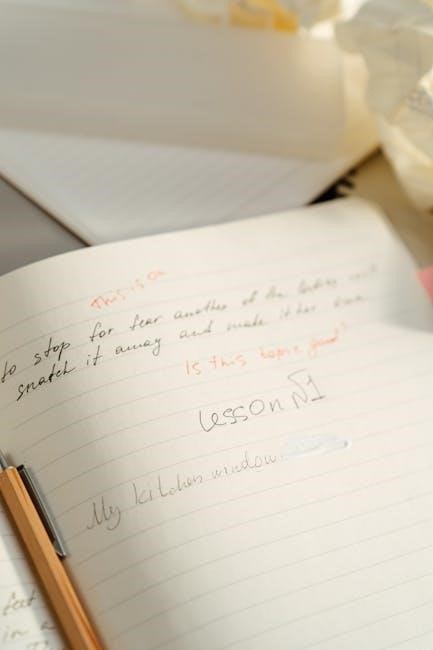The Diary of Anne Frank play script PDF is a powerful adaptation of Anne Frank’s iconic diary, capturing her emotional journey during the Holocaust․ This convenient PDF format offers an accessible way to explore the play’s themes, characters, and historical significance, making it an invaluable resource for educational and theatrical purposes․
Overview of the Play Script PDF
The Diary of Anne Frank play script PDF is a detailed adaptation of Anne Frank’s iconic diary, transformed into a powerful stage production․ The PDF includes character descriptions, sample monologues, and scene designs, providing a comprehensive overview of the play․ Set in a warehouse and office building, the play captures the claustrophobic realities of eight people hiding from Nazi persecution․ With 121 pages, the script includes descriptions of four rooms, music manuscripts, and a scene design chart․ This format ensures a consistent reading experience, making it ideal for educational and theatrical use․ The play has been adapted and performed worldwide, serving as a poignant reminder of hope, resilience, and the human condition during one of history’s darkest periods․
Availability and Accessibility of the PDF
The Diary of Anne Frank play script PDF is widely available for free download on various online platforms, including educational websites, Google Drive, and Scribd․ Its popularity stems from the convenience of the PDF format, which preserves the original layout and formatting, ensuring a consistent reading experience across all devices․ This accessibility makes it an ideal resource for educational settings, personal use, and theatrical preparations․ The PDF is also easily shareable, allowing global access to Anne Frank’s powerful story․ With just a few clicks, users can download the full script, making it a readily accessible tool for learning about the Holocaust and its emotional impact․

Historical Context of the Play
The play is set during World War II, depicting the Holocaust and its impact on Jewish families like Anne Frank’s, offering a poignant reflection of real historical events․
The Life and Legacy of Anne Frank
Anne Frank, born in 1929 in Frankfurt, Germany, is one of the most iconic figures of the Holocaust․ Her diary, documenting life in hiding during WWII, became a global symbol of hope and resilience; Anne’s family fled to Amsterdam to escape Nazi persecution, where they lived in secret for two years․ Tragically, they were discovered in 1944, and Anne died in Bergen-Belsen in 1945․ Her diary, found by her father Otto, was published in 1947 and has since been translated into over 70 languages․ Anne’s legacy endures as a powerful reminder of the human spirit’s strength and the atrocities of war, inspiring countless adaptations, including the play script․
The Transformation of the Diary into a Play
Anne Frank’s diary was first adapted into a play by Frances Goodrich and Albert Hackett in 1955, with the support of Anne’s father, Otto Frank․ The play captures the emotional depth of Anne’s diary, condensing her two-year experience in hiding into a dramatic narrative․ It maintains the core themes of hope, resilience, and humanity while adapting the personal reflections into dialogue and stage directions․ The play premiered on Broadway, winning a Pulitzer Prize, and has since been performed globally․ This adaptation ensures Anne’s story reaches a wider audience, preserving its historical and emotional significance for future generations․ Its success highlights the diary’s universal appeal and timeless message․

Structure of the Play
The play is structured into acts that chronologically depict the Frank family’s life in hiding․ Each act builds tension, reflecting the characters’ emotional journeys and struggles․
The Setting of the Play
The play is set in the Secret Annex, a hidden apartment in Amsterdam where Anne Frank, her family, and four others lived in hiding during WWII․ The confined space, above Anne’s father’s office, reflects the characters’ isolation and fear․ The setting spans from 1942 to 1944, capturing the tense atmosphere of living in hiding․ The annex’s cramped quarters amplify the emotional struggles and interpersonal conflicts․ Its layout, with shared spaces and limited privacy, underscores the challenges of communal living under duress․ The setting serves as a constant reminder of the characters’ precarious situation and the external dangers they face, heightening the play’s dramatic tension and emotional depth․
Scene Design and Layout
The scene design of The Diary of Anne Frank play emphasizes the cramped and intimate nature of the Secret Annex․ The multi-level set often features a central living area, a staircase, and upper sleeping quarters, recreating the annex’s tight spaces․ Lighting plays a crucial role, with dim tones evoking a somber mood and highlighting the characters’ confinement․ The layout ensures that the audience feels the claustrophobia and tension of living in hiding․ Props, such as Anne’s diary and a radio, are strategically placed to emphasize key themes and moments․ The design creates a visually immersive experience, drawing the audience into the emotional and physical confines of the annex․

Characters in the Play
The play features Anne Frank, her family, and others in hiding, portraying their struggles and relationships․ Each character’s unique traits and interactions drive the emotional narrative forward․
Main Characters and Their Roles
The play centers around Anne Frank, the young and spirited narrator, whose diary entries form the emotional backbone of the story․ Her father, Otto Frank, is portrayed as a symbol of hope and resilience, striving to maintain normalcy in their hiding place․ Anne’s mother, Edith, and sister, Margot, also play pivotal roles, showcasing their struggles and strengths․ The Van Pels family—Hermann, Auguste, and Peter—add complexity with their contrasting personalities, while Fritz Pfeffer, the dentist, brings a unique perspective․ Each character’s role highlights their individual struggles and contributions to the group’s survival, creating a rich tapestry of human emotions and dynamics․
Supporting Characters and Their Significance
The supporting characters in the play, such as Miep, Jan, and Mr․ Kraler, are pivotal in providing hope and assistance to the Frank family․ Miep’s unwavering dedication and kindness highlight the humanity that exists even in dire circumstances․ Jan and Mr․ Kraler risk their lives to supply the family with essential goods, embodying courage and compassion․ These characters serve as a bridge between the hidden world of the Franks and the outside, offering moments of relief and connection․ Their roles underscore the theme of resilience and the importance of human kindness in the face of adversity, making them indispensable to the story’s emotional depth․

Key Scenes and Moments
The play captivates with its poignant opening scene, introducing Anne’s diary, and the heart-wrenching moment the Nazis discover the annex, creating unbearable tension and despair; Anne’s final, emotional farewell as she’s taken away leaves a lasting impact, emphasizing the tragedy and resilience of the characters․
The Opening Scene and Its Impact
The opening scene of The Diary of Anne Frank play captivates audiences by introducing the cramped, secretive atmosphere of the annex․ It sets the tone for the story, showcasing the characters’ initial hopes and fears as they begin their hiding․ Anne’s voiceover, narrating her diary entries, immediately establishes her as the emotional core․ The scene’s simplicity, focusing on whispers and flickering light, creates an intimate connection with the audience․ This moment lays the groundwork for the play’s emotional resonance, drawing viewers into the characters’ desperate struggle for survival and highlighting the diary’s role as a lifeline for Anne’s spirit․
Climactic Scenes and Their Emotional Weight
The play reaches its emotional peak with the discovery of the annex and the arrest of the Frank family․ These climactic scenes are deeply unsettling, evoking a sense of dread and inevitability․ The chaotic atmosphere, the sound of boots, and the characters’ desperation create a heart-wrenching experience․ Anne’s final moments on stage, where she expresses hope for a better world, contrast tragically with the impending doom․ These scenes leave audiences in profound silence, underscoring the brutality of the Holocaust and the loss of innocence․ The emotional weight of these moments lingers, emphasizing the play’s powerful message about humanity’s capacity for both good and evil․

Themes and Messages
The play explores universal themes of hope, resilience, fear, survival, humanity, and compassion, offering a poignant reflection on the human condition during the Holocaust․
Hope and Resilience in the Face of Adversity
Anne Frank’s diary is a testament to the power of hope and resilience․ Even in the most dire circumstances, she remained steadfast in her belief in a better future․ Her diary, adapted into a play, vividly portrays her unwavering optimism․ Through her words and actions, the play highlights how hope became a source of strength not just for Anne but for everyone in the Secret Annex․ Her resilience in the face of adversity continues to inspire audiences, showing the importance of maintaining hope even when all seems lost․ This universal message transcends time, making her story a enduring symbol of the human spirit․
Fear, Survival, and the Human Condition
The play adaptation of Anne Frank’s diary vividly portrays the constant fear of discovery and the daily struggle for survival in the Secret Annex․ The characters’ lives are defined by the oppressive atmosphere of war, with each moment overshadowed by the threat of capture․ Their fear is palpable, yet their will to survive remains unbroken․ The play delves into the human condition, exploring how individuals cope with extreme adversity․ It reveals the psychological and emotional toll of living in hiding, while also highlighting the resilience of the human spirit․ This duality of fear and survival makes the story deeply relatable and emotionally profound for audiences worldwide․
The Importance of Humanity and Compassion
The play adaptation of Anne Frank’s diary underscores the profound importance of humanity and compassion amidst unimaginable hardship․ The selfless acts of those who risked their lives to protect the Frank family, such as Miep and Jan, exemplify the enduring power of kindness․ Even in the confined and oppressive environment of the Secret Annex, moments of empathy and support among the characters highlight the human need for connection․ These acts of compassion not only sustain hope but also remind the audience of the inherent goodness that exists even in the darkest times․ The play serves as a poignant reminder of the necessity of humanity in preserving dignity and hope during adversity․

Educational and Emotional Significance
The play serves as a powerful educational tool, teaching students about the Holocaust and fostering empathy․ Its emotional depth resonates globally, enriching both education and personal reflection․
Using the Play in Educational Settings
The play script of The Diary of Anne Frank is widely used in schools to educate students about the Holocaust and its impact on individuals․ Teachers incorporate the script into history and literature curricula to foster empathy and understanding of historical events․ The play’s emotional and historical depth encourages critical thinking and reflection among students․ It also provides a relatable lens through which young people can explore themes of identity, hope, and resilience․ Many educators use the script to teach dramatic arts, encouraging students to perform scenes and analyze characters․ This multidisciplinary approach makes the play a valuable resource for comprehensive learning experiences․
Emotional Impact on Audiences Worldwide
The play adaptation of The Diary of Anne Frank has left an indelible emotional imprint on audiences globally․ Its poignant portrayal of hope, fear, and resilience resonates deeply, evoking empathy and reflection․ The story’s universal themes, such as the struggle for survival and the preservation of humanity, transcend cultural boundaries․ The play’s ability to convey the atrocities of the Holocaust through a personal lens creates a profound connection with viewers․ Many have reported feeling a mix of sadness and inspiration, as Anne’s unwavering optimism amidst unimaginable suffering inspires hope․ The play’s emotional weight has made it a powerful tool for raising awareness and fostering compassion worldwide․

Downloading the Play Script PDF
Downloading the Diary of Anne Frank play script in PDF format is easy, ensuring accessibility for educational and personal use globally today․
Popular Platforms for Download
The Diary of Anne Frank play script PDF is widely available on various platforms, ensuring easy access for readers and educators worldwide․ Google Books, Amazon, and educational repositories like Google Scholar offer free or paid versions of the script․ Additionally, many school and university libraries provide digital access through their databases․ Platforms like Scribd and PDF Drive also host downloadable versions, catering to diverse audiences․ These platforms ensure that the play script remains accessible, fostering its educational and cultural impact globally․ Their user-friendly interfaces make it convenient for anyone to download and explore the play script in PDF format․
Accessibility and Convenience of the PDF Format
The PDF format of the Diary of Anne Frank play script offers unparalleled accessibility and convenience․ It can be easily downloaded and accessed on various devices, including laptops, tablets, and smartphones․ The format ensures that the play script retains its original layout, making it simple to read and navigate․ PDFs are also searchable, allowing users to quickly locate specific scenes or characters․ This convenience makes it ideal for educational purposes, as students and educators can easily reference key moments․ Additionally, PDFs are lightweight and require minimal storage space, ensuring they can be shared and stored effortlessly․ This accessibility helps preserve the play’s legacy and reach a global audience․

Critical Reception and Reviews
The Diary of Anne Frank play script has received widespread critical acclaim for its powerful portrayal of hope and resilience, effectively capturing the emotional depth of Anne Frank’s story․
Audience Reception and Feedback
The Diary of Anne Frank play script has deeply resonated with global audiences, evoking powerful emotions and fostering reflection on humanity’s resilience․ Spectators often describe the production as hauntingly beautiful, praising its ability to bring Anne’s story to life with authenticity․ Many find the play’s raw emotion and poignant dialogue unforgettable, creating a lasting impact․ Educational groups and theater enthusiasts alike appreciate its faithful adaptation of the diary, making it a vital tool for understanding historical atrocities․ The play’s universal themes of hope and survival continue to captivate audiences, ensuring its relevance across generations․ Its emotional depth leaves viewers moved and inspired, solidifying its place as a timeless theatrical experience․
Critical Acclaim and Reviews
The Diary of Anne Frank play script has garnered widespread critical acclaim for its poignant and faithful adaptation of Anne’s diary․ Critics praise its ability to capture the emotional depth and historical significance of the original text while translating it into a powerful theatrical experience․ Reviewers highlight the script’s balance between intimacy and universality, making it a compelling read for both educational and personal purposes․ Many commend its accessibility, noting how it bridges the gap between the written word and the stage, preserving Anne’s voice and legacy․ The script is often celebrated as a vital educational resource, offering a deeply moving exploration of hope, humanity, and resilience in the face of unimaginable adversity․

Sources and References
The Diary of Anne Frank play script PDF is available through official sources like the Anne Frank House website, educational institutions, and public libraries worldwide․
Official Websites and Reliable Sources
The official website of the Anne Frank House provides access to the play script PDF, ensuring authenticity and adherence to the original content․ Additionally, the United States Holocaust Memorial Museum and the Anne Frank Center USA offer reliable downloads․ Educational institutions and public libraries worldwide also provide access to the PDF, often through their databases or digital archives․ These sources are trusted for their accuracy and respect for copyright․ Always prioritize official or educational platforms to ensure the quality and legitimacy of the material․ Avoid unofficial sites to maintain the integrity and intended message of Anne Frank’s story․
Libraries and Educational Institutions
Libraries and educational institutions are vital resources for accessing the Diary of Anne Frank play script PDF․ Many university and public libraries offer digital access through their databases, such as JSTOR or ProQuest, ensuring students and researchers can utilize the material for academic purposes․ Additionally, schools often incorporate the play into their curriculum, providing copies for classroom use․ Libraries may also host physical copies of the script, making it accessible to the community․ These institutions play a crucial role in preserving and sharing Anne Frank’s story, supporting educational initiatives and fostering a deeper understanding of historical events․ Their resources are invaluable for scholars and learners alike․
The Diary of Anne Frank play script PDF remains a powerful educational and emotional tool, offering insights into history, humanity, and hope․ Explore it to understand its enduring impact․
Final Thoughts on the Play Script PDF
The Diary of Anne Frank play script PDF is a poignant tribute to Anne’s legacy, offering a deeply emotional and educational experience․ It captures the essence of hope, resilience, and the human spirit, making it a vital resource for understanding history․ The PDF format ensures accessibility, allowing audiences worldwide to engage with the story․ As a theatrical adaptation, it bridges the gap between literature and performance, preserving Anne’s voice for future generations․ The play not only honors her memory but also serves as a reminder of the importance of compassion and humanity․ It is a must-read for anyone seeking to connect with this historic tale on a profound level․
Encouragement to Explore the Play
Exploring the Diary of Anne Frank play script PDF is a powerful way to connect with one of history’s most poignant stories․ It offers a unique opportunity to delve into themes of hope, resilience, and humanity, making it an invaluable resource for both educational and personal enrichment․ The play’s universal message transcends time, encouraging reflection on tolerance and courage․ By engaging with the script, readers gain a deeper understanding of Anne’s experiences and the broader historical context․ It is a call to empathy and a reminder of the strength of the human spirit․ Embrace this story and let its lessons resonate with you․

